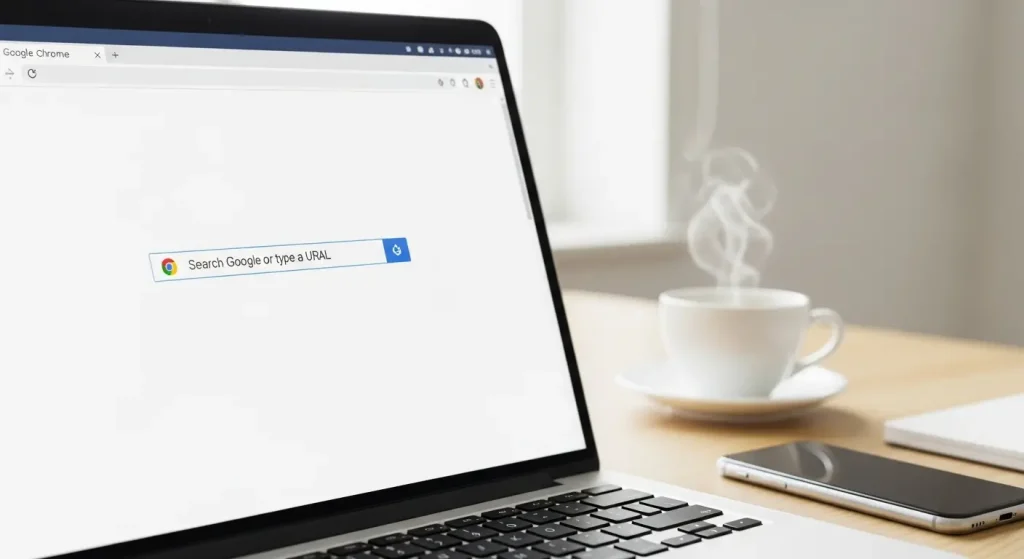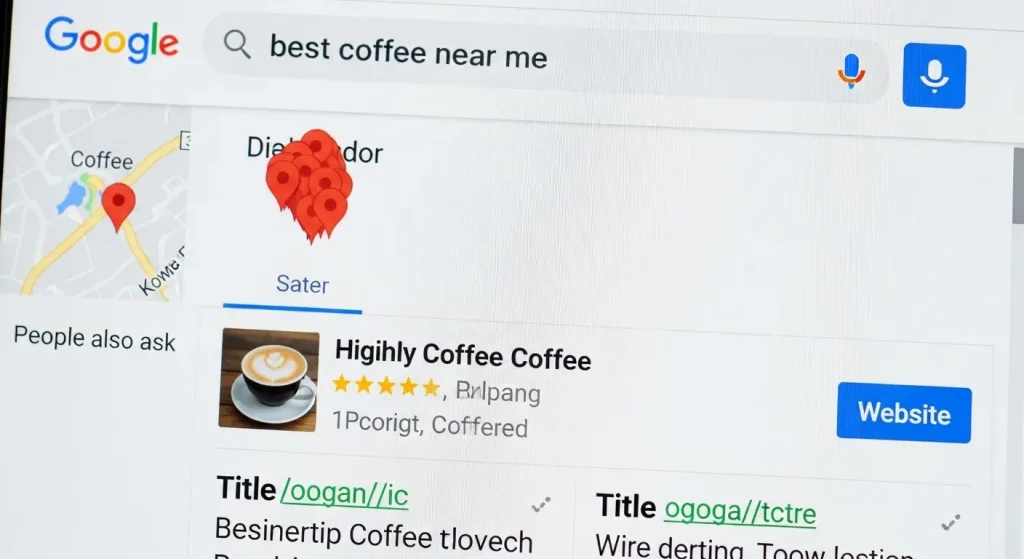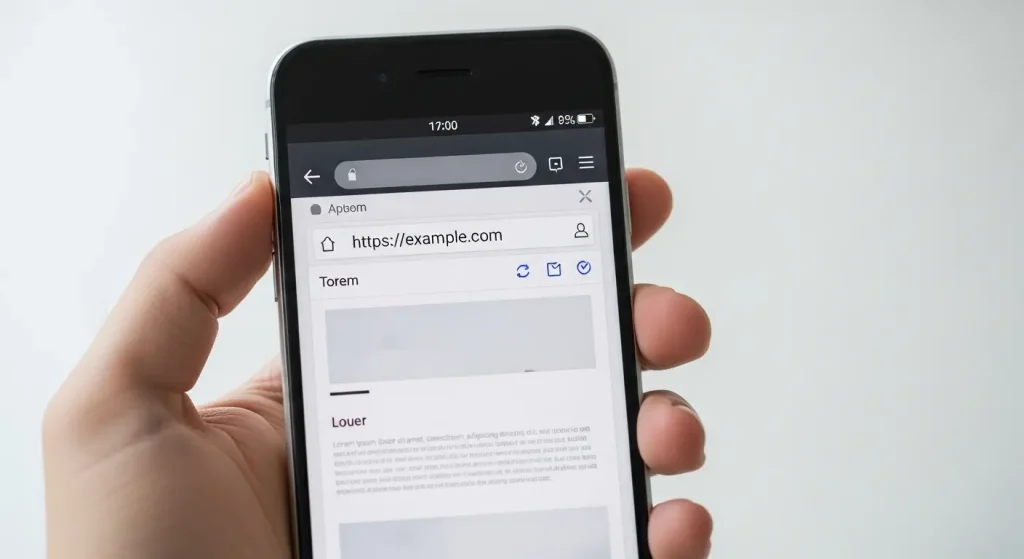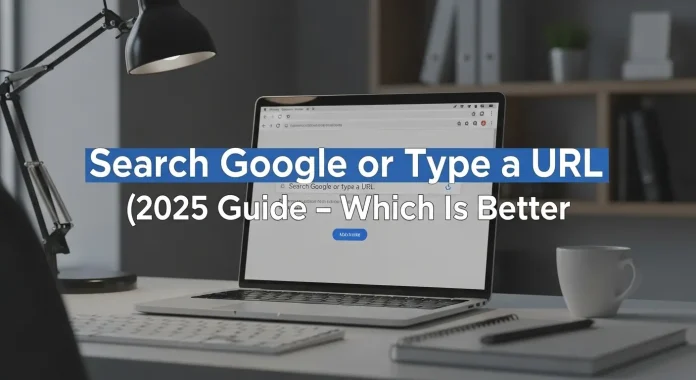Table of Contents
You open your browser, see the familiar line “Search Google or type a URL”and pause.
Should you type your question into Google, or go straight to the website you want?
It seems like a small choice, but it can affect how fast you find information, how secure your browsing is, and even how search engines understand your intent.
In today’s digital-first world, where over 8.5 billion Google searches happen daily, understanding when to search and when to type a URL can help you browse smarter, faster, and more securely.
Let’s explore what actually happens behind the scenes—and which method gives you the best results.
What Does “Search Google or Type a URL” Really Mean?
When you open a new tab in Google Chrome, you’ll often see the message: “Search Google or type a URL.”
This simple phrase offers two distinct ways to navigate the web:
- Search Google: Enter a keyword, phrase, or question (e.g., “best coffee near me”), and Google’s algorithm fetches relevant websites for you.
- Type a URL: Directly type a web address (e.g., “starbucks.com”) and go straight to that site without a Google search.
The line you see isn’t just text it’s called the Omnibox, a smart search-and-navigation bar that combines a browser’s address bar with Google’s powerful search engine.

How Search Engines Work Behind the Scenes
When you perform a Google search, a lot happens in just a fraction of a second.
Here’s how:
- You type your query.
Google checks its massive index of billions of web pages. - Autocomplete kicks in.
It predicts what you’re looking for using your past searches, trending topics, and popular global queries. - Natural Language Processing (NLP) interprets your intent.
For instance, if you type “amazo,” Google assumes you meant “Amazon.” - Personalization adjusts results.
Your location, device, search history, and preferences all shape what you see. - The ranking algorithm decides order.
Google’s complex algorithm ranks websites based on relevance, authority, and usability to show you the best results first.
The goal is simple: get you the most relevant and trustworthy information instantly.
[link to related article on my site about how Google Search algorithms work]
What Happens When You Type a URL
Typing a web address—like **www.nike.com**—bypasses the search engine and goes directly to that website.
Here’s what happens technically:
The Process For Your Browser Loading A Website:
Your browser finds the website’s server IP address, and then it connects to the website which will then fully load.
No third-party data collection or search engine inquiry takes place in the process.
If the correct web address is known, it will also be the quickest and most private way to access the website because it will filter through Google’s search results.
The Role of the Omnibox in 2025: More Than a Search Bar
In 2025, Google’s omnibox is redefined to be a smart tool designed for multitasking and increased productivity.
It can now:
- Autocomplete your favorite websites
- Perform quick calculations and conversions
- Translate text and show weather updates
- Accept voice commands for hands-free searching
- Suggest apps, websites, and even browser settings
It’s more than a search bar—it’s your personal AI-powered web assistant.
That’s why users today don’t always distinguish between searching and typing—they do both in the same bar seamlessly.
When to Search on Google (and Why It’s Worth It)
You should use Google Search when:
- You don’t know the exact site name or spelling.
→ Example: Typing “Linkedn” still finds LinkedIn. - You want multiple options or comparisons.
→ Example: “Best digital marketing agencies in New York.” - You’re researching or exploring ideas.
→ Example: “How to improve SEO ranking.” - You want reviews or diverse perspectives.
→ Google’s SERPs (Search Engine Result Pages) give you articles, reviews, and related queries. - You want AI-powered suggestions.
→ Google now uses AI summaries and predictive search to refine your intent.
In short, use search when you’re exploring or comparing.
When to Type a URL (and Why It’s Faster)
You should type a URL when:
- You know the exact website address.
→ Example: “bbc.com” or “amazon.com.” - You frequently visit the same site.
→ Your browser’s memory will even auto-complete it for you. - You want privacy.
→ No search tracking or ads appear when you bypass Google. - You’re saving time.
→ Going directly cuts out the search engine step.
So, typing a URL is perfect for direct access and repeat visits.
Omnibox vs Traditional Search: What’s the Difference?
| Feature | Search Google | Type a URL |
| Purpose | Explore or discover content | Go directly to a known website |
| Speed | Slower (due to ranking and indexing) | Faster (direct server connection) |
| Privacy | Moderate (data tracked) | Higher (less data sharing) |
| Use Case | Research, comparison, queries | Direct access, known destination |
| Technology Used | Search engine algorithms | DNS resolution |
Both serve a purpose. The smart choice depends on your goal.
Benefits of the “Search Google or Type a URL” Tool
This dual-purpose feature simplifies web navigation. Here’s why it matters:
1. Efficiency
You can search or navigate directly from one place—no need to open separate tabs or windows.
2. Smarter Predictions
Google’s autocomplete suggests accurate queries, reducing typing effort.
3. Personalized Experience
The Omnibox learns from your browsing behavior and offers personalized suggestions.
4. Time-Saving
You can perform quick actions (calculations, translations, conversions) right in the address bar.
5. Seamless User Journey
Switching between searching and visiting websites feels effortless, making browsing smoother.
Advanced Google Search Tips (for Power Users)
If you use Google often, these search operators can make your searches precise and powerful:
- site: limits results to one domain
→ site:bbc.com climate change - related: finds sites similar to a domain
→ related:nytimes.com - cache: shows Google’s saved version of a page
→ cache:example.com - inurl: searches for keywords inside URLs
→ inurl:marketing - intitle: finds pages with a word in the title
→ intitle:SEO tips
These advanced tricks help marketers, researchers, and businesses extract specific data faster.
[link to related article on my site about Google Search operators]
What Does “Search Google or Type a URL” Mean?
The phrase “Search Google or type a URL” appears in your browser’s address bar (also known as the Omnibox in Chrome). It’s a dual-function field that allows you to:
- Search Google:
Type any keyword, phrase, or question (e.g., “best coffee near me”) and the browser will send your query to Google to show search results. - Type a URL:
Enter a website address directly (e.g., www.example.com), and the browser will take you straight to that website — no search results in between.
In short, you can either search for content or navigate directly to a specific website.
💡 Example:
Typing facebook.com takes you directly to Facebook.
Typing Facebook login searches Google for pages related to “Facebook login.”
Should I Search Google or Type or Enter a URL?
That depends on your goal.
| Situation | Best Option | Why |
| You know the exact website address | Type the URL | Direct, faster, more secure |
| You’re looking for information or exploring options | Search Google | Discover relevant results |
| You’re unsure of the correct domain (e.g., .com or .net) | Search Google | Avoid typos or phishing sites |
Pro Tip:
Typing a full URL ensures you land directly on the official site and avoid copycat domains.
How Do I Type a URL?
Typing a URL (Uniform Resource Locator) is straightforward once you understand its parts:
Example: https://www.example.com/about-us
- https:// → The secure web protocol
- www. → The website prefix (optional)
- example.com → The domain name
- /about-us → The specific page path
Steps:
- Click the browser’s address bar.
- Type the full or partial URL (e.g., example.com).
- Press Enter to visit directly.
If the site uses HTTPS, browsers automatically connect securely. Modern browsers like Chrome, Safari, and Edge even auto-complete URLs you visit frequently.
How to Search in the URL Bar
If you want to use Google directly from the address bar, just type your query and press Enter. The browser automatically sends it to Google (or your default search engine).
For example:
- Typing “best pizza near me” triggers a Google search.
- Typing “linkedin.com” takes you directly to the website.
This dual-use functionality is why it’s called the Omnibox — it’s both a search engine box and a navigation bar in one.

What Is the Difference Between Searching Google and Typing a URL?
Let’s break it down:
| Feature | Search Google | Type a URL |
| Purpose | To find content or answers | To go to a specific website |
| Process | Goes through Google’s search engine | Goes directly to web server |
| Speed | Slightly slower (adds search step) | Faster, direct access |
| Privacy | Query stored in Google’s logs | Direct visit, less data shared |
| Example | “weather today” | weather.com |
In short:
- Searching Google = Exploration.
- Typing a URL = Navigation.
If you’re a business owner, both matter — because people might search for your brand or type your website directly. Ensuring you’re optimized for both behaviors is crucial for visibility.
How Do You Search or Type a URL?
When you open Chrome or Safari, the process is identical:
- To search: Just type what you want to know → “How to fix slow Wi-Fi.”
- To type a URL: Enter the full domain → speedtest.net.
If you accidentally mix both, don’t worry. Chrome automatically detects whether you meant a search or a website.
What Happens When We Search a URL in Google?
When you search a URL (like typing youtube.com into Google’s search box), Google doesn’t take you to the site directly. Instead, it shows results about that website — such as pages, reviews, or similar domains.
For instance, searching facebook.com on Google displays:
- The official Facebook site
- Related links
- Frequently asked questions
- Cached versions or subpages
This can be useful when you want to verify authenticity before visiting or learn more about a domain.
Why Is Google Not Showing My Full URL in Search Results?
Google often simplifies URLs in search results for clarity. Instead of showing the full URL (like https://www.example.com/blog/how-to-grow-seo), it might display:
example.com › blog › how-to-grow-seo
This is part of Google’s visual simplification update, helping users focus on content, not cluttered URLs.
However, for SEO professionals and webmasters, this means:
- Always use clear breadcrumb structures
- Keep URLs short, readable, and keyword-rich
🔗 Reference: Google Search Central – URL Best Practices
How Do I Get to Know My URL on My Phone?
Finding your URL on a mobile device is easy:
On Android (Chrome):
- Open the website.
- Tap the address bar.
- Copy or view the full URL.
On iPhone (Safari):
- Open the webpage.
- Tap and hold the address bar.
- The full link will appear; tap “Copy.”
If you’re creating content or sharing a website, knowing the exact URL is essential — especially for marketing campaigns or backlink tracking.

Why Does the Chrome URL Bar Suggest Google Searches First Instead of Previous URLs?
Chrome’s smart prediction algorithm prioritizes popular search terms and recent activity. If many people have searched for a phrase recently, Chrome will suggest it before your old typed URLs.
It’s designed to save time and show contextually relevant suggestions, especially if your previous visits were infrequent.
However, you can customize this behavior by:
- Clearing search history
- Disabling autocomplete
- Changing your default search engine (Settings → Search Engine → Manage)
SEO and Branding Insight: Why This Matters for Businesses
From an SEO perspective, understanding “Search Google or type a URL” is more than user behavior — it’s part of your brand visibility funnel.
Here’s how:
- Direct Traffic (Typed URLs): Reflects brand trust. People know your domain and visit directly.
- Organic Search Traffic (Google Searches): Reflects discovery. Users find you through content, blogs, or keywords.
Both are vital.
If users are searching your brand name but not typing your URL, it may mean your brand awareness needs strengthening.
Example:
A user types “Amazon” instead of amazon.com — this counts as a Google search before navigation. Strong brands dominate both routes.
How to Optimize for Both Search and Direct Entry
1. Strengthen Your Domain Recognition
Use a short, memorable, and easy-to-type domain.
2. Optimize for Branded Searches
Ensure your homepage, social profiles, and business listings appear for brand-related queries.
3. Implement HTTPS and SSL
Secure sites build trust and appear safely when typed directly.
4. Build Backlinks to Strengthen Authority
Backlinks help both Google Search and auto-suggestions recognize your site as authoritative.
(Example: [link to related article on my site])
5. Add Schema Markup
Helps Google display enhanced results like breadcrumbs, sitelinks, and contact info.
6. Encourage Bookmarks & Direct Visits
Invite loyal users to bookmark your site or install your app for instant access.
SEO & Brand Visibility Insight
For businesses, understanding this concept isn’t just technical—it’s strategic.
Most users reach websites through search, not direct typing. According to StatCounter (2024), search engines account for 53% of web traffic, while 40% comes from direct URLs.
That means if your brand isn’t visible in Google search results, you’re missing half of your potential audience.
👉 Want your website to show up when people search on Google?
Partner with an expert SEO service provider to boost visibility, ranking, and organic traffic.
Conclusion: Search or Type? It Depends on Your Goal
If you’re exploring—go with Google Search.
If you’re targeted—just type the URL.
In modern browsers, the Omnibox integrates both approaches harmoniously, combining exploration and direct navigation into one fluid experience.
Having a deeper understanding of this distinction allows for quicker and more secure web navigation.
Frequently Asked Questions (FAQs)
1. When should I search Google and when should I type a URL?
If you know the exact website address, type the URL directly. If you’re exploring or comparing options, searching on Google is more effective.
2. What does “Search Google or type a URL” mean?
It’s a browser prompt offering two ways to browse—search via Google or go directly to a known site.
3. What is the Omnibox in Chrome?
The Omnibox is Chrome’s combined address and search bar. It lets you search Google or type a web address in one place.
4. How can I improve my Google search results?
Use specific keywords, quotation marks for exact matches, and operators like “site:” or “intitle:” for refined results.
5. Can I use the Omnibox for more than just searching?
Yes. You can use it for calculations, conversions, voice searches, translations, and even opening apps.
6. Does typing a URL improve privacy?
Yes. When you type a URL directly, you bypass search tracking, improving privacy.
Check more useful articles here



